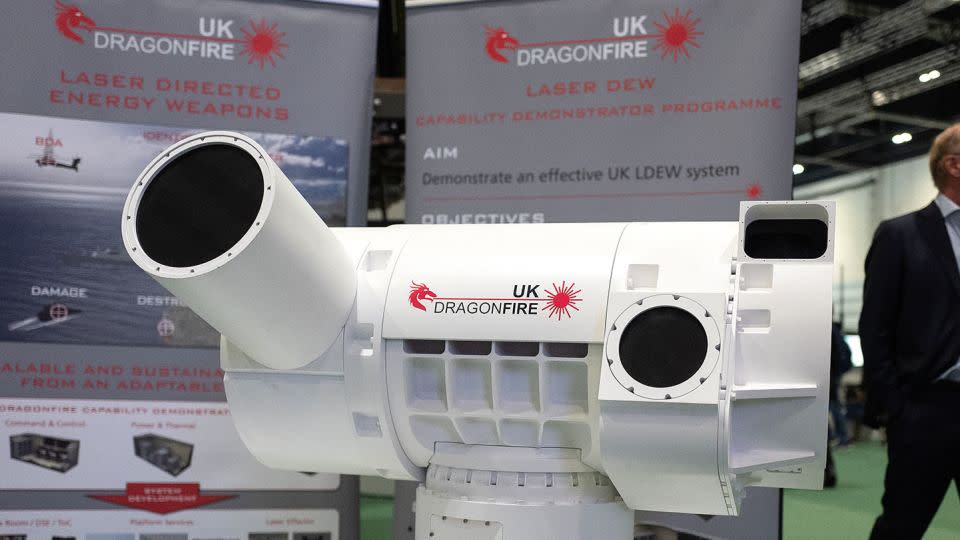Air defense for $13 a shot? How lasers could revolutionize the way militaries counter enemy missiles and drones
Britain this week showed off a new laser weapon that its military says could deliver lethal missile or aircraft defense at around $13 a shot, potentially saving tens of millions of dollars over the cost of missile interceptors that do the job now.
Newly released video of a test of what the United Kingdom’s Defense Ministry calls the DragonFire, a laser directed energy weapon (LDEW) system, captured what the ministry says was the successful use of the laser against an aerial target during a January demonstration in Scotland.
“It’s a potential game changer for air defense,” the video says as a bright laser beam pierces the night sky over a firing range in the remote Hebrides archipelago, creating a ball of light as it hits its target.
The Defense Ministry says the DragonFire can precisely hit a target as small as a coin “over long ranges,” but it did not offer specifics. The exact range of the weapon is classified, it said.
The laser beam can cut through metal “leading to structural failure or more impactful results if the warhead is targeted,” a UK Defense Ministry statement said.
And it is claimed it also take out its targets for a tiny fraction of what current air defense missiles cost.
The Defense Ministry put the price of firing a 10-second laser burst at around $13. In contrast, the Standard Missile-2 used by the United States Navy for air defense costs more than $2 million per shot.
“It has the potential to be a long-term low-cost alternative to certain tasks missiles currently carry out,” a January statement from the UK Defense Ministry said.
The cost of air defense missiles has become a hot topic in defense circles in recent years as low-cost drones have shown their effectiveness in on battlefields in Ukraine and in attacks by Houthi rebels against commercial and military ships in the Red Sea and Gulf of Aden.
Analysts have questioned how long the US, UK and their partners can keep using multi-million-dollar missiles against Houthi drones that can in some cases be acquired for well under $100,000.
Meanwhile expensive air defense systems from Western allies have been crucial to Ukraine’s ability to defend itself from attacks by Russian missiles and drones.

“Low-cost drones and rockets have swung the economic calculus of offense and defense in favor of those using large volumes of cheap unmanned systems and munitions to overwhelm more-sophisticated air and missile defenses,” James Black, assistant director defense and security for the RAND Europe think tank, wrote in a blog post in January.
DragonFire could help swing that calculus back in the UK’s favor, Black said.
“This type of cutting-edge weaponry has the potential to revolutionize the battlespace by reducing the reliance on expensive ammunition,” UK Defense Secretary Grant Shapp said in January after the DragonFire test.
Unproven and limitations
But Black and others note that lasers like DragonFire are still unproven on the battlefield and will have limitations.
Writing for The Conversation last month, Iain Boyd, director of the Center for National Security Initiatives at the University of Colorado, ticked off some problems with lasers.
Rain, fog and smoke scatter the light beams and diminish effectiveness; laser weapons release a lot of heat so require large cooling systems; mobile lasers, mounted on ships or aircraft, will need battery recharges; and the lasers must stay locked on moving targets for up to 10 seconds to burn holes in them, Boyd said.
The British are not the first in developing a laser that can shoot down an aerial target.
In 2014, the Navy successfully tested and deployed a laser weapon system on the USS Ponce in the Persian Gulf.
The system was capable of engaging drones, small aircraft and small boats. In 2020 and 2021, the Navy tested a more advanced laser system on the USS Portland.
In 2022, a laser system was installed on the guided-missile destroyer USS Preble. That system is still undergoing testing, Rear Adm. Fred Pyle, director of the Navy’s Surface Warfare Division, said at a January symposium, according to Breaking Defense.
Also in 2022, the US Navy successfully tested a high-energy laser system against a target representing a cruise missile.
But a Navy account of that test said there was no plan to get it into the hands of warfighters, adding that it “offers a glimpse into the future of laser weapons.”
A 2023 report the from the US Government Accountability Office (GAO) noted the Pentagon’s success in testing laser weapons, but said it needs to do more to get them to troops, including figuring out their exact missions and acquisition strategies.
“DOD has long noted a gap—sometimes called “the valley of death”—between its development and its acquisition communities that impede technology transition,” the GAO report said.
But British defense leaders say there’s a new imperative to get lasers onto the modern battlefield and no time to waste in doing so.
“In a world of evolving threats we know that our focus must be on getting capability to the warfighter and we will look to accelerate this next phase of activity,” Shimon Fhima, director strategic programs for the UK Defense Ministry, said in a statement.
For more CNN news and newsletters create an account at CNN.com


